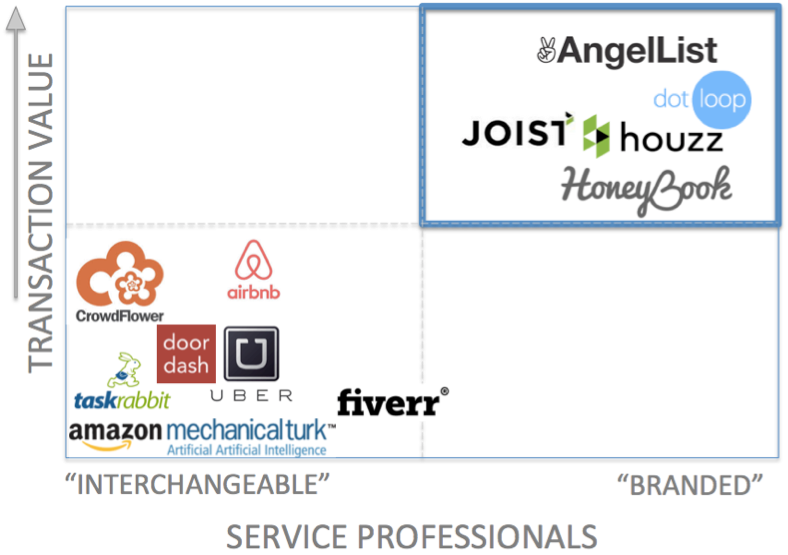 From Social Networks To Market Networks
From Social Networks To Market Networks
Most people didn’t notice last month when a 35-person company in San Francisco called HoneyBook announced a $22 million Series B*.
What was unusual about the deal is that nearly all the best-known Silicon Valley VCs competed for it. That’s because HoneyBook is a prime example of an important new category of digital company that combines the best elements of networks like Facebook with marketplaces like Airbnb — what we call a market network.
Market networks will produce a new class of unicorn companies and impact how millions of service professionals will work and earn their living.
What Is A Market Network?
“Marketplaces” provide transactions among multiple buyers and multiple sellers — like eBay, Etsy, Uber and LendingClub.
“Networks” provide profiles that project a person’s identity, then lets them communicate in a 360-degree pattern with other people in the network. Think Facebook, Twitter and LinkedIn.
What’s unique about market networks is that they:
- Combine the main elements of both networks and marketplaces
- Use SaaS workflow software to focus action around longer-term projects, not just a quick transaction
- Promote the service provider as a differentiated individual, helping to build long-term relationships

An example will help: Let’s go back to HoneyBook, a market network for the events industry.
An event planner builds a profile on HoneyBook.com. That profile serves as her professional home on the web. She uses the HoneyBook SaaS workflow to send self-branded proposals to clients and sign contracts digitally.
She then connects to that project the other professionals she works with, like florists and photographers. They also get profiles on HoneyBook, and everyone can team up to service a client, send each other proposals, sign contracts and get paid by everyone else.

This many-to-many transaction pattern is key. HoneyBook is an N-sided marketplace — transactions happen in a 360-degree pattern like a network. That makes HoneyBook both a marketplace and network.
A market network often starts by enhancing a network of professionals that exists offline. Many of them have been transacting with each other for years using fax, checks, overnight packages and phone calls.
By moving these connections and transactions into software, a market network makes it significantly easier for professionals to operate their businesses and clients to get better service.
We’ve Seen This Before
AngelList is also a market network*. I don’t know if it was the first, but Naval Ravikant and Babak Nivi deserve a lot of credit for pioneering the model in 2010.
On AngelList, the pattern is similar. The startup CEO can complete her fundraising paperwork through the AngelList SaaS workflow, and everyone in the network can share deals, hire employees and find customers in a 360-degree pattern.
Joist is another good example. Based in Toronto, it provides a market network for the home remodel and construction industry. Houzz is also in that space, with broader reach and a different approach*. DotLoop in Cincinnati shows the same pattern for the residential real estate brokerage industry.
Looking at AngelList, Joist, Houzz, DotLoop and HoneyBook, the market network pattern is visible.

Six Attributes Of A Successful Market Network
Market networks target more complex services. In the last six years, the tech industry has obsessed over on-demand labor marketplaces for quick transactions of simple services. Companies like Uber, Mechanical Turk, Thumbtack, Luxe and many others make it efficient to buy simple services whose quality is judged objectively. Their success is based on commodifying the people on both sides of the marketplace.
However, the highest value services — like event planning and home remodeling — are neither simple nor objectively judged. They are more involved and longer term. Market networks are designed for these types of services.
People matter. With complex services, each client is unique, and the professional they get matters. Would you hand over your wedding to just anyone? Or your home remodel? The people on both sides of those equations are not interchangeable like they are with Lyft or Uber. Each person brings unique opinions, expertise and relationships to the transaction. A market network is designed to acknowledge that as a core tenet — and provide a solution.

Collaboration happens around a project. For most complex services, multiple professionals collaborate among themselves — and with a client — over a period of time. The SaaS at the center of market networks focuses the action on a project that can take days or years to complete.
Market networks help build long-term relationships. Market networks bring a career’s worth of professional connections online and make them more useful. For years, social networks like LinkedIn and Facebook have helped build long-term relationships. However, until market networks, they hadn’t been used for commerce and transactions.
Referrals flow freely. In these industries, referrals are gold, for both the client and the service professional. The market network software is designed to make referrals simple and more frequent.
Market networks increase transaction velocity and satisfaction. By putting the network of professionals and clients into software, the market network increases transaction velocity for everyone. It increases the close rate on proposals and expedites payment. The software also increases customer satisfaction scores, reduces miscommunication and makes the work pleasing and beautiful. Never underestimate pleasing and beautiful.
Social Networks Were The Last 10 Years. Market Networks Will Be The Next 10.
First we had communication networks, like telephones and email. Then we had social networks, like Facebook and LinkedIn. Now we have market networks, like HoneyBook, AngelList, Houzz, DotLoop and Joist.
You can imagine a market network for every industry where professionals are not interchangeable: law, travel, real estate, media production, architecture, investment banking, personal finance, construction, management consulting and more. Each market network will have different attributes that make it work in each vertical, but the principles will remain the same.
Over time, nearly all independent professionals and their clients will conduct business through the market network of their industry. We’re just seeing the beginning of it now.
Market networks will have a massive positive impact on how millions of people work and live, and how hundreds of millions of people buy better services.
I hope more entrepreneurs will set their sights on building these businesses. It’s time. They are hard products to get right, but the payoff is potentially massive.
by James Currier (@JamesCurrier)
Is Markethive one of the new pioneers called a Market Network?
Please comment below what do you think?
Alan Zibluk Markethive Founding Member
